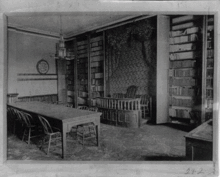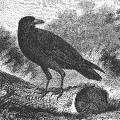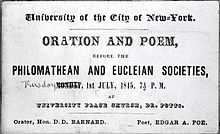Eucleian Society

Origins
In 1832 sixteen students began the Eucleian Society at New York University, originally under the name “Adelphic Society”. After debate the name Eucleian was chosen in honor of Eukleia- εὔκλεια, the Goddess of Repute, Glory and War, associated with Artemis, the Goddess of the Hunt and protector of women and children.[2] The Society had as a rival, the Philomathean Society at New York University.[3] While both Societies forbade membership in their rival society, early records show that members were sometimes punished when discovered to be holding mutual membership and a few resigned to join the rival society.
During the period of its founding, student societies such as Eucleian Society collected their own libraries and augmented their instruction by employing the noted minds of their day. Literary and debate societies offered a departure from the learn-by-rote instruction that prevailed in much of university instruction. Benefiting from a trust formed by A. Ogden Butler and family,[4] the organization had a stable source of revenue. The Eucleian Society provided its membership at NYU with a library and augmented student instruction. The University gave the Society its own rooms at the Main University Building. The Eucleian Meeting Parlor was said to be "fitted up in a style of taste and elegance highly creditable to the young gentlemen members."
Secrecy
The Constitution of the Eucleian Society as well as custom stressed secrecy among members. At some point it seems that even honorary membership was no longer a feature of the Society despite the fact several sitting American Presidents had accepted honorary membership in the Society.[5]
The organization was well known enough in New York City to be announced in major newspapers in throughout the 19th century, despite of its habits of secrecy. On occasion Eucleians hosted open forums for important topics of the day, inviting lecturers of great popularity and fame. Politics, current affairs, literature (especially the Gothic and Romantic popular in the era), and university events seems to have been the most popular topics for internal essays, orations and discussions. The Society also employed repeated symbolism, allegory and other seemingly mystical allusions in its writings, none of which are fully explained in its writings. Until the turn of the 20th century, officers of the Eucleians also gave public speeches at commencement, apparently occupying a central position in those functions. This practice was ended to preserve the privacy of the Society's membership.[6]
While there are some archived documents and older publications in circulation, there is very limited information about the Society as a result of its secrecy. In some of the archival records and internal records kept by the Society information has been removed, while other information is written in a kind of shorthand, and even the name of the Society itself is omitted on many documents.
Culture
Little has been shared about the system or workings of the organization. The process of membership is said to take several months and to be multi-staged. The aim of the process has been described in general terms to create familiarity among the members and to inculcate the values of the Society. The primary values are excellence, faithfulness, development of the individual, mutual assistance in supporting each member's aspirations and social responsibility. Members are selected once or twice a year.
To date, the Society refuses to induct female members.
If anything could be said about the prevailing culture of the Society during its early era is that it tended to be “progressive”, supporting gender equality and abolition at an early juncture. Society members took an unusually keen interest in the plight and nature of Native Americans, hosting and producing a series of lectures and essays on the philosophy and nobility of the "Indian Character".[7] Perhaps owing to influences from University leaders and advisors such as Rev. James M. Matthews and Theodore Frelinghuysen, a number of Society members became noted Protestant clergy and Protestant religious scholars.
The Society was a manifestation of student debate and literary societies that were popular prior to fraternities and sororities. It is not surprising that men on the Eucleian rolls gave rise to the Zeta Psi fraternity in 1847. These organizations were influenced by Freemasonry's moral code based on Enlightenment philosophy and ritualism. The William Morgan Affair which gave rise to anti-Masonic witch-hunts forced increased secrecy among fraternal organizations, undoubtedly affecting the ethos of secrecy among the Eucleian Society and like organizations.
One early lecturer became a very popular figure with the Society. Edgar Allan Poe was a repeated guest of the Eucleian, and lived on the Square; his poem "The Raven", which had given birth to his celebrity, also became popularly associated with the Society.[8][9] In a fictional work based on New York University’s history of "secret societies" author Linda Fairstein uses the term “Raven Society”, noting that it was also used in references to a New York University literary society that had an association to Edgar Allan Poe.[10] (There is also a Raven Society at the University of Virginia.) References in early yearbooks, and fraternity insignia that Ms. Fairstein cited gave rise to the use of "Ravens" or "Raven Society", as an alterne name though it is clear the Society rejects this as a formal name and deny Poe was a singular influence.

Two Society publications, The Medly and the Knickerbocker, became popular well beyond campus with New Yorkers in the mid 19th century through the 1920s. Much of the writing was humorous and satirical, finding its fodder in the events and figures of both campus and city. It is not entirely clear which members took part in writing the articles for these literary collections since members of the Society had taken to use nom de plumes. Some of the listed and identifiable writers of the Knickerbocker went on to write for the new Harper's Magazine reducing the Knickerbocker to a magazine only of student interest until it ended publication.[11][12] Another circle of Washington Square writers originally associated with the Society (but expanded to non-members)took on the name Ravens in the 1930s to 1950s.[13]
In the late 1930s and 1940s the Society became increasingly separate from the University despite having on-campus accommodations. Numbers in the organization dwindled in the 1940s as a result of World War II. Another cause for Eucleian’s lower profile seems to have been the perception of elitism by other NYU students. A quip in a yearbook of the era describes Eucleian as having membership that includes “John Quincy Adams, The Rockefellers, and that crowd”. (The organization did consist largely of the social "elite" of the time.) This alleged snobbery also became a theme of self-effacing humor in the diminishing external publications of the Society in this era; the Society refers to itself, and presumably Andiron Club as "the reclusive old Establishment" in a 1930s NYU yearbook. This tongue-in-cheek reference had to do with the club not taking part as a unit in spirited student games, competitions and hazing of freshmen that occurred in the early fall at NYU.
By mid-20th century on to 1980s, membership also came to encompass New York area students, faculty and literati with and without New York University affiliation.[14] It was at this time late Coleman O. Parsons, (a professor at Columbia and graduate of Columbia and Yale) became the first head of the group with no NYU affiliation.
Other non-specific cultural manifestations, outside of the serious work of self and societal benefit have been noted; in a 1965 Club correspondence a description of the Eucleian claims a "history of pranks in bad taste; formals in good taste and celebrations where taste is temporarily put aside."
Modern era
The increased popularity of Greek letter fraternities in the 1950s and the anti-establishment sentiment of the 1960s (which was especially strong at NYU) diminished the Eucleian Society further. The Society widened its membership to all university schools (the Society had been primarily but never strictly an undergraduate organization). This was done possibly to buoy its prospects of survival. The practice had limited success, as attendance failed, affecting recruitment. Records (and lack thereof) seem to reveal years on end when there was no recruitment of new membership from student ranks during this era.

Joint meetings had always occurred with the avowed rival Society, Philomathean. By the early 20th century Philomathean had transformed itself into the Andiron Club which continued to profess a rivalry with the Eucleian Society, at least constitutionally. Despite this, the two organizations, removed from their once lofty and central positions in the NYU campus firmament, joined functions and crossed membership, as (increasingly public) membership lists attest to- eventually arriving at a level of synonymity. By mid-20th century on to 1980s, membership also came to encompass students, faculty and literati with and without University affiliation.[14] Relaxed formality, ritual, etc. seems to have prevailed from the late 1960s onwards. NYU continued as the base of activity though membership was drawn from a wider community. During this era the Societies opened their doors to women membership. This continued through the time of the loss of the University Heights campus and the consolidation of New York University operations to Washington Square in the 1970s. In the reduced circumstances (without university recognition or the continued benefit of the Ogden Butler Trust) activities continued at least through the 1980s and 1990s, under the sponsorship of a faculty members from the English Departments at NYU and Columbia.[15]
In the late 1980s and 1990s, the remaining student membership of the organization attempted to revitalize its undergraduate operations as a senior society. During this time the organization functioned at various sites on campus, with the support of sympathetic faculty and for a time from rented rooms in the East Village. Secrecy seems to have been increased by design, in part because of differences with some alumni and faculty membership and partly to prevent what was seen as hostility towards independent student organizations.
It is not clear what the Society engages in today due to its strict policy of privacy. It is referenced in various underground student organizations and journals.[16][17][18] In these limited statements or references the Society often appears critical of New York University administration, and various educational and social institutions. There are also allusions to its continued function as a literary, oration and debate society. Its historic documents also seem to describe what is a fraternal organization as well. Membership of the Society seems to be based on student (and faculty) achievements and activity in literature, oration, journalism, debate, (media and performing) arts, science, fraternity and sorority membership, athletics and government. Its membership also continues to be drawn from New York area universities.
There is a recent upswing in curiosity and pursuit of membership in Societies similar to the Eucleian.[citation needed] Partially it is lore and media attention to Societies like Skull and Bones, Quill and Dagger, Sphinx, Philomathean, St. Anthony Hall, and others. There are reasons beyond idle curiosity that attract students, with some serving as literary outlets, while most provide a venue to engage in varied topics of discussion, and the opportunity to share genuine fraternal values.
Some Notable Members
Accessible lists of members of the Societies (Eucleian, Philomathean and Andiron) are traditionally limited, the criteria being whether members have passed or whether their names were published in the groups' public journals. All available lists reads as an impressive register of distinguished individuals in arts, literature, government, business, science and education. A sampling from available individuals yields these names among many other noted individuals.
- Alfred Vail - Scientist, Businessman
- William Butler Ogden - Businessman
- LeRoy Elwood Kimball - Educator
- Ivy Ledbetter Lee - Businessman, Politician, Educator
- Benjamin Franklin Butler -Businessman, Politician
- Charles Butler - Businessman
- Elihu Root - Businessman, Educator
- James M. Matthews - Religious Leader, Educator
- Theodore Frelinghuysen - Educator, Politician
- William Weston Patton - Educator
- Richard Grant White - Author, Educator
- James Augustus Suydam - Artist, Businessman
- Harry Woodburn Chase - Educator, Business Leader
- Albert Gallatin - Politician, Businessman
- James Ford Rhodes - Historian
- Jerome S. Coles - Scientist, Businessman
- Elmer Holmes Bobst - Scientist, Businessman
- William Cullen Bryant - Author, Educator
- Anning Smith Prall - Politician
- Elijah Ward - Lawyer, Judge, Politician
- Arthur Vivian Watkins - Judge, Politician
- William H. Draper - Politician
- William Henry Draper, Jr. - Military Leader, Politician
- Edward Smith - Athlete, Businessman
- Elmer Kenneth Strong - Athlete, Businessman
- A. Oakley Hall - Politician, Lawyer
- James Edward Murray - Politician, Businessman
- Jeremiah Whipple Jenks - Educator, Politician
- Edward I. Edwards - Politician, Businessman
- Howard Crosby - Educator, Religious Leader
- Ernest Howard Crosby - Politician, Educator, Religious Leader
- Lyman Abbott - Educator, Religious Leader, Politician
- Samuel Tilden - Politician, Businessman, Lawyer
- Arthur Walsh -Politician
- Harry Woodburn Chase- Educator
- Charles Waldo Haskins - Businessman, Educator
- Allan Langdon McDermott - Businessman
- Charles Wilkes Christenberry - Military Leader, Educator
- Avery Fisher - Inventor, Businessman
- Bliss Carman - Poet, Educator
- William Sage Woolworth, Jr. - Businessman, Author
- Anthony Jerome Griffin - Politician
- Romare Bearden - Author, Artist
- James Lopez-Watson - Judge, Civil Rights Pioneer
- Smith Ely Jr. - Politician
- John C. Sawhill - Politician, Educator
- James W. Tuttleton - Educator, Author
- Henry Townley Heald- Educator, Business Leader
- James Loomis Madden - Educator, Business Leader
- John Thomas Madden - Educator, Business Leader
- Robert F. Wagner - Politician
- Mitchell Jenkins -Politician
- Royal Jenkins Davis - Author, Politician
- W. B. Boyd-Carpenter - (International) Religious Leader, Author
- Hugo C.M. Wendel - Historian, Author
- Elmer Ellsworth Brown - Educator
- William Henry Brown - Artist, Educator
- Wilford Seymour Conrow - Artist, Educator
- Richard Threlkeld Cox - Mathematician, Educator
- Henry Pratt Fairchild - Sociologist, Educator
- Dixon Ryan Fox - Sociologist, Educator
- John William Draper - Scientist, Author
- Henry Draper - Scientist, Educator
- John Harvey Kellogg -Scientist
- Steven Beckwith Ayers - Politician
- Walter Reed -Scientist
- Willard E. Atkins - Political Economist, Educator
- Roswell Parkhurst Barnes -Educator, Religious Leader
- Tasker Lowndes Oddie - Politician
- Mark W. Everson Military Leader
- John William Gilbert - Politician
- Louis Freeh - Government
- Robert Swan Mueller III - Government
- Robert Michael White - Politician
- Jack Peckett - Educator
- Coral Lansbury - Author, Historian, Educator
- Frederic Tuten - Author, Educator
- Coleman O. Parsons - Author, Educator
Note on Societies
Said author and researcher Kevin Phillips, “People have wondered why these secret societies have been hotbeds of future success. Rather than competing with fraternities and student organizations, these ‘secret societies’ augment or leverage other organizations. What makes them unique and singularly successful is that they stress goal oriented vision among a limited and distinguished group. Often they assist each other, secretly, in gaining prominent campus positions as practice for what they want to do in the real world. As opposed to larger organizations they maintain the strength of their ties throughout their lives."
External links
- Eucleians Speak
- Obscure Societies Have history of Influence
- Secret Societies that You (Probably) Don't Know
- Poe's Legacy Lives On
- Ask Elmer: Flag, Halloween Walk, Tracks, Judson
- Revealed! Conspiracies: Deadly Secret Societies
- They have corporate sponsorship.
References
- ↑ "Adelphic Society Records 1832-1833". Notes on Constitution and By-laws of Eucleian. New York Athenaeum Society. 1821.
- ↑ Athenian Political Art from the Fifth and Fourth Centuries BCE: Images of Political Personifications
- ↑ http://dlib.nyu.edu:8083/archead/servlet/SaxonServlet?source=/philomathean.xml&style=/saxon01a2002.xsl&part=body Constitution of Philomathean Society
- ↑ The Central Trust
- ↑ http://dlib.nyu.edu:8083/archead/servlet/SaxonServlet?source=/eucleian.xml&style=/saxon01a2002.xsl&part=body Acceptance speeches and letters of Honorary Members
- ↑ http://dlib.nyu.edu:8083/archead/servlet/SaxonServlet?source=/eucleian.xml&style=/saxon01a2002.xsl&part=body Farewell and Valedictory Addresses
- ↑ NYU Archives - Greenwich Village
- ↑ 175 Facts About NYU
- ↑ E. A. Poe Society of Baltimore
- ↑ Backstory : Linda Fairstein’s Backstory for ENTOMBED
- ↑ §11. New York: "The Knickerbocker Magazine; The Knickerbocker Gallery". XX. Magazines, Annuals, and Gift-books, 1783–1850. Vol. 16. Early National Literature, Part II; Later National Literature, Part I. The Cambridge History of English and American Literature: An Encyclopedia in Eighteen Volumes. 1907–21
- ↑ Harper's New Monthly Magazine Articles
- ↑ Guide to the Raven Poetry Circle of Greenwich Village CollectionCa. 1933- ca. 1954PR 108
- ↑ 14.0 14.1 Andiron Club of New York City, Members List (1907-1934)
- ↑ http://dlib.nyu.edu:8083/archead/servlet/SaxonServlet?source=/andiron.xml&style=/saxon01a2002.xsl&part=body Records of Andiron Club
- ↑ http://eucleiansocietyblogspot.com
- ↑
- ↑